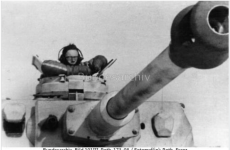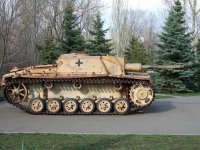wayne556517
Lieutenant General
- Joined
- Aug 28, 2007
- Messages
- 16,932
What are peoples thoughts on this beast, it is still available, was there a problem with it?
The main issue is the absence of anti-magnetic Zimmerit coating, which was present on all tanks and SPGs from December 1943 to September 1944.What are peoples thoughts on this beast, it is still available, was there a problem with it?
And also, still that unrealistic blackened muzzle brake !.





Hunter, aesthetics aren't really my priority.Mastercom, you might be better served saying your preference is for a non-blackened muzzle brake, because you think it looks better. There's absolutely nothing wrong with that, and I'm sure there are other collectors who share your sentiment.
However, making a factual declaration that a blackened muzzle brake is unrealistic is just incorrect, especially on a winter whitewashed Stug.
First, batches of KwK 40 and StuK 40 muzzle brakes were literally finished in solid black and installed in AFVs. Second, the photographic record has scores of pictures (like the ones below) of whitewashed Panzer IVs and Stugs with their KwK40/StuK40 muzzle brakes solid black after seeing action. First Legion's treatment of the blackening is actually very realistic, where the muzzle brake itself is black and then there is less powder residue weathering on the cannon barrel the farther it gets away from the muzzle brake.
View attachment 358450
View attachment 358451
View attachment 358452
View attachment 358453
View attachment 358454
Hunter, aesthetics aren't really my priority.
However, I am very skeptical that the muzzle brakes blackened so uniformly due only to firing.
The Germans did not use black powder, and therefore their ammunition was smokeless.
The combustion gases travel forward at high speed so they do not curl around backward to deposit soot.
In fact, I think the muzzle brakes must have had some kind of discoloration due to the extreme heat generated by the firing.
You mentioned that the 75mm KwK40 and StuK40 guns were literally finished in solid black and installed on the tanks and SPGs.
I have no information on this and would be interested to know your sources if you're willing.



And that's a very good thing !.As for aesthetics issue, I think the black muzzle brake dead horse has been beat to death, and you could probably move on from it. First Legion's more recent models like the Jagdpanzer IVs, Elefant, and Ferdinand have muzzle brakes with a LOT less black weathering. It's almost non-existent on the Ferdinand. So it seems First Legion has not been "systemically blackening" muzzle brakes for a few tank releases now.
Thank you for this very thorough and well-documented answer.I'd submit that two of your assumptions are incorrect:
The Germans did not use black powder, and therefore their ammunition was smokeless.
- the "smokeless" powder used in German ammunition just means it did not produce excessive smoke that lingered and floated on the battlefield. Smokeless powder still produces plenty of black carbon fouling.
The combustion gases travel forward at high speed so they do not curl around backward to deposit soot.
- The muzzle brake directs a good amount of gases to the sides, and even slightly rearward. This re-direction of the vector of the propellant gases is what provides a braking action to the cannon recoil.
There are LOTS of historic pictures that show very darkened muzzle brakes on winter whitewashed Panzer IVs and Stug IIIs. To me, the majority of them look like carbon following, with a pattern that starts around the muzzle brake and when fired enough extends backwards to the cannon barrel behind the face of the cannon. That is my interpretation. It could be heat at the muzzle brake or even the cannon blast chipping/wearing off the whitewash paint. All are plausible explanations to me. I personally think carbon fouling played a role.
The solid black factory finished muzzle brakes is documentedin the photographic record. I've posted this picture before of factory Stug IIIs with grey cannon barrels and black muzzle brakes at the assembly firm. Below is also a picture of Stug III pulled from a bog in Russia still in it's original paint that has a solid black muzzle brake and one in with it's crew in front of it. The second and third pictures in my post above are also of Stug IIIs with grey barrels and solid black muzzle brakes.
View attachment 358737
View attachment 358739
View attachment 358738
Interpreting black and white photos is extremely difficult, and you can only really definitively tell if it is a black muzzle brake vs a grey muzzle brake if the vehicle is clean and the lighting is just right. There's enough of these types of pictures that it was definitely a thing. Before my last computer crashed, I used to have a historic picture of a Russian 155mm howitzer that the Germans captured a put back in service that they repainted in solid Dunkelgel with a solid black muzzle brake.
For AFVs, I've only seen definitive pictures of them mounted on KwK 40 and StuK 40 cannons on the Panzer IV and Stug III. Since the Stug IV has the same StuK 40 cannon, a solid black muzzle brake on that assault gun is plausible to me. I do not know how prevalent the solid black muzzle brakes were. Most of the definitive photos I have are from lat 1942 to 1943 production AFVs, so it's possible this could have only been a thing for a few months or that only one or a few of the muzzle brake sub-contractors finished them in black.
Mysteries like this are what keep me fascinated with WW2 German armor. I've also learned to keep a very open mind on German armor, as it seems to always surprise me with these weird little production idiosyncrasies that don't seem realistic. Another example of a realistic feature that seems unrealistic would be the camo pattern that is on the lower hull below the sponsons of the JJD MNH striped Panther. I specifically told John to paint it there, because the Germans painted this area too for the factory painted camo schemes, as odd as it seems. It was confirmed by period photos and Roddy McDougall, the late author of the preeminent tome on Panther factory camo schemes.
Cheers.
Simply to discuss on a public discussion forum ....If aesthetics aren't your priority, why do you spend so much time on the FL forum, a company which is all about aesthetics?
I completely agree, enjoying this hobby remains the most important thing.As an everyday collector I can honestly say that I have always liked the blackened muzzle break.
At one point I remember reading how lower quality powder and the weather are involved in this type of buildup.
From there you can try and mathematically out how many tanks among those produced could be affected by those factors.
Then I stopped and decided to enjoy my hobby.
Simply to discuss on a public discussion forum ....
Issues I'm noticing are quite real and not just "shi&t posting".Sure, but you should be more fair. You never have anything at all nice to say. Only shi&t posting.
And I would like to point out that this does not prevent me from collecting certain First Legion figurines that I really like.
And yet it is quite real !.Not sure such a thing exists.

